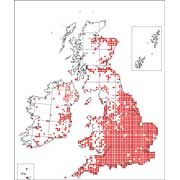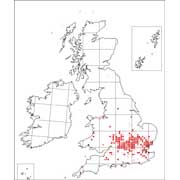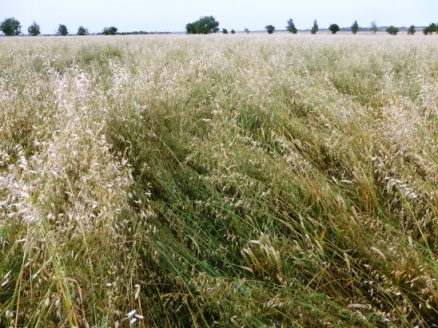- Wild oat
Biology and Impact
In the UK, there are two main species which frequently occur as weeds of arable crops.
Avena fatua – common or spring wild-oat occurs throughout England; more scattered distribution in Scotland and Wales. Recorded in 55% of the 2852 10 x 10 km grid squares surveyed for the Atlas of the British Flora (2002). See map:

It germinates mainly in spring (March/April) but with a variable, and sometimes considerable, amount of autumn germination too (mainly Sept/Oct).
Avena sterilis ssp. ludoviciana – winter wild-oat is less common and mainly found within 50 – 100 miles of Oxford where it was first recorded in the wild in 1910. Recorded in 10% of the 2852 10 x 10 km grid squares surveyed for the Atlas of the British Flora (2002), but probably under-reported. See map:

It germinates mainly in autumn and winter, from October to early March, and is more tolerant of freezing conditions than common wild-oat.
Both species may occur within a single field, sometimes in mixture but sometimes in discrete, separate patches.
Why does identification of species matter?
- Winter wild-oat is generally considered the more challenging species to control, requiring more robust strategies.
- Seedling emergence patterns and winter hardiness differ between the two species so correct identification can help determine the best herbicide timing and non-chemical control strategy.
- Although herbicide resistance has been found in both species, it is relatively more common in winter wild-oat – the first cases of resistance in the UK were all found in this species.
Please see our detailed identification leaflet
Damage: wild-oats are one of the most competitive of the common grass-weed species with similar competitive abilities to Italian rye-grass and sterile brome. A population of five plants/m2 typically causes a yield loss of 5% in cereals, but much higher crop losses can occur in severe infestations, especially if crop lodging occurs. High populations can slow harvesting and, because not all seeds are shed before harvest, there can be considerable contamination of grain and straw, especially in winter barley.

A field of herbicide-resistant wild-oats in Essex in 2014 – a situation to be avoided
Agro-ecology – biology underpinning control strategies: seeds of both wild-oat species tend to have longer dormancy, and be slightly more persistent in the soil, than black-grass, rye-grass and bromes. Longevity of seeds in annually, deeply cultivated soil is not as great as is often believed, being similar to black-grass (70 – 80% decline per year). However, in the absence of cultivations, such as under a grass ley or seeds below the depth of cultivation, survival can be greater. The large size of wild-oat seeds means that seedlings can emerge from greater depths (10 – 15 cm or more) than most other grass-weeds. Populations tend not to build up as fast as other major grass-weeds as fewer seeds are produced. One consequence is that the level of control needed to prevent populations increasing is only 75 – 85%, which is much less than that for black-grass (>95%). This is the main reason why wild-oats have been relatively easier to control than other grass-weeds.
Management Options
Preventing seed production should enable wild-oat populations to be substantially reduced within two – three years, but total eradication is a considerable, but not totally unrealistic, challenge. Reducing infestations to at least roguable levels should be the aim. The more protracted emergence patterns and potential for emergence from greater depths (10 – 15 cm or more) in the soil means that non-chemical methods of control, such as later autumn drilling, spring cropping and ploughing, are less effective than for other major grass-weeds.
- Do not rely solely on herbicides – integrate their use with non-chemical methods wherever possible.
- Prevent importation and spread of seeds in combine harvesters, grain, balers, seed, straw, manure and cultivation equipment. Wild-oat seeds are unlikely to survive anaerobic digestion (AD), although this needs verification.
- Rogue plants, or spray off patches, in June wherever possible. This should be done before seeds start shedding (usually late June onwards in cereals). Whole plants must be removed, rather than just the panicles, otherwise regrowth will occur. Studies in the 1970’s concluded that it should be possible to rogue populations of up to 400 – 500 wild-oat plants/ha but this is likely to take 2 – 4 man hours/ha.
- If wild-oats are confined to distinct patches or parts of the field, try to contain the problem to those areas by hand roguing the rest of the field, even if this is impractical within the badly infested areas. This is especially important if herbicide resistance has been confirmed within a patch in order to prevent further spread and the subsequent formation of ‘satellite’ patches of resistant wild-oats.
- Map wild-oat patches in June/July. Identify the species present as this can help determine the best herbicide, cultivation and cropping strategy.
- Delaying post-cereal harvest cultivations for as long as possible encourages the loss of seeds lying on the soil surface. Such natural losses of freshly shed seeds outweigh the benefit of earlier cultivations aimed at encouraging germination of these, and older, seeds. The longer the delay in cultivating, the greater the benefit in terms of seed loss. The best cultivation strategy for wild-oats may conflict with the best strategy for other grass-weeds, such as sterile brome, where early post-harvest cultivations are recommended. In mixed grass-weed populations, a decision on time of cultivation should be based on the most problematic species and the ease with which the different species can be controlled by alternative methods.
- Ploughing is generally less effective at controlling wild oats than other major grass-weeds, such as black-grass, because plants can emerge successfully from seeds germinating at greater depths (10 – 15 cm or more). Ploughing down wild oats seeds tends to preserve their dormancy but also brings to the surface seeds buried in previous seasons. Ploughing after a period of several years of non-inversion tillage, direct drilling or grass leys may result in substantial emergence of wild-oat seedlings. In such cases, sufficient time should be allowed for plants to emerge and be destroyed prior to drilling a crop.
- Delayed autumn sowing has much less benefit for wild-oat control, compared with black-grass, rye-grass and bromes, because of its more protracted germination pattern. However, there may be some benefit as young seedlings of common wild-oats are sensitive to frost, but frost hardiness increases once they have reached the three leaf stage, which is more likely in early drilled crops.
- Spring cropping, especially if repeated for two or more years, can reduce populations of winter wild-oats, which mainly germinate in autumn, but may encourage spring germinating common wild-oats. The time of sowing spring crops can have a big impact on infestations with more opportunity in later sown crops to destroy wild-oats pre-sowing.
- Establishing spring crops by direct drilling or with minimal soil disturbance may reduce the numbers of wild-oats that germinate in the crop. It is important that any wild-oat plants which have emerged pre-drilling are destroyed with a non-selective herbicide.
- Wild-oats are very susceptible to competition, especially at the early growth stages, and a strongly competitive crop will assist other control measures.
- Post-emergence herbicides in wheat are usually very effective at controlling wild-oats, provided all have emerged by time of application. These include the ACCase inhibitors (‘fops’/’dims’/’dens’) clodinafop, fenoxaprop and pinoxaden, and the ALS inhibitors mesosulfuron+iodosulfuron and pyroxsulam mixtures. Of these, only pinoxaden can be used in barley crops.
- Tri-allate, a thiocarbamate herbicide, has a different mode of action to most other wild-oat herbicides and can provide very useful control of wild-oats when used pre or early post-emergence in cereals.
- Pre-emergence herbicides used for control of other grass-weeds may give some control of wild-oats, but much will depend on emergence patterns. Autumn applied pre-emergence herbicides are unlikely to control spring emerging wild-oats.
- Inclusion of non-cereal break crops enables the use of other herbicides, including propaquizafop, quizalofop, cycloxydim, clethodim and propyzamide which can all be used in oilseed rape. Note specific recommendations for use in other crops.
- Apply post-emergence herbicides according to label recommendations. Be aware that the ideal timing for wild-oat control may conflict with the best timing for control of other grass-weeds, such as black-grass, rye-grass and bromes.
Herbicide resistance:
Herbicide resistant wild-oats were first found in the UK in 1994 and now occur on >250 farms in 28 counties. Resistance has been identified in both species. ACCase (‘fop’/’dim’/’den’) target site resistance has been found but, in contrast to black-grass, this tends to affect ‘fops’ only and not ‘dims’ (e.g. cycloxydim) or ‘dens’ (pinoxaden), which often remain effective. However, enhanced metabolic resistance is the commonest mechanism and this can reduce the efficacy of most ACCase and ALS inhibiting herbicides.
Although resistance in wild-oats is currently much less of a problem compared with black-grass, the risk should not be ignored because:
- All the most effective wild-oat herbicides are either ACCase or ALS inhibitors which are ‘high risk’ from a resistance perspective.
- There is high dependency on herbicides as, in contrast to other grass-weeds, fewer effective non-chemical methods of control are available.
If resistance is suspected, seed samples should be collected in late July and tested in standard assays.